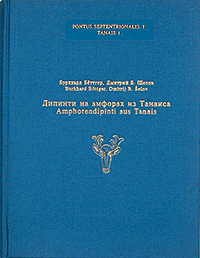|
|
|
|
|
| AUTHOR: | |
Burkhard Böttger, Dmitrij Šelov
Бурхард Бёттгер, Дмитрий Шелов |
|
| |
| TITLE: | |
Amphorendipinti aus Tanais
Дипинти на амфорах из Танаиса
|
| |
| SERIES: | |
Pontus Septentrionalis
I, Tanais 1 |
| |
| PUBLISHER: | |
Paleograph Press;
Deutsches Archäologisches Institut;
Institute of Arcaeology, Russian Academy of Sciences;
Center for Comparative Study on Ancient Civilizations,
Russian Academy of Sciences |
| |
| YEAR: | | Moskau, 1998 |
| |
| LANGUAGE: | | Bilingual Edition (in German and in Russian) |
| |
| ISBN: | |
5-89526-002-0 |
| |
| FORMAT: | | 22 × 29 cm |
| |
| PAPER: | | Offset paper, 120 gram |
| |
| COVER: | |
Hardcover, cloth
|
|

|
| PAGES: | | 344 pages, including:
9 line drawing plates with excavations plans;
91 line drawing plates with dipinti copies |
| |
| WEIGHT: | |
3 kg / 6.6 lbs |
| |
| PRICE: | |
39.00
Euro (+postage)
35.00 Euro (+postage) with the subscription
to at least three volumes of Pontus Septentrionalis
(with 10% discount for each volume) |
|
***
The city of Tanais was founded by the Bosporan Greeks in the second half of III BC on the Tanais river’s north bank (contemporary Don) at its juncture with the ancient Meotide (Azov Sea). The settlement is surrounded by numerous necropolises with underground burials and kurgans. Archaeological excavations on the territory of the settlement and its adjacent necropolises were sporadically conducted already at the turn of the XIX–XX centuries and systematic study of the settlement did not begin until 1955, the year when the Lower Don Archaeological Expedition of the Institute of Archaeology of the Russian Academy of Sciences was set up. The expedition still actively conducts field research.
It has been established that the city of Tanais was founded by the Bosporan Greeks and that from the time of its establishment it developed as a Greek-barbarian trade and handicraft production centre at the periphery of the Classical World. At the end of the I century AD the city was destroyed by the Bosporan king Polemon, but had then quickly recovered and in II–1st half of III century AD reached the peak of its development. It is to this historical period that the major architectural complexes are dated, among which are warehouse cellars with well-preserved amphorae. In the middle of III century AD Tanais suffered complete destruction by invaders, probably Gothic tribes. The destruction was so devastating that the city never managed to recover.
The present volume is dedicated to the publication and study of amphorae dipinti (inscriptions) found during archaeological excavations at Tanais in the period between 1955–1979. The practice of inscribing vessels, especially amphorae, was wide-spread throughout many regions of the Classical World. Such inscriptions, however, have not drawn enough scholarly attention so far, especially when compared with the number of studies dealing with other types of ceramic epigraphy such as seals or graffiti engraved on the vessels.
Already in the period between 1955 and 1979 there were more than 3,000 inscriptions found in Tanais. Most of them have been published and studied in this volume. What makes the dipinti from Tanais particularly interesting to researchers is the fact that the majority of them come from confined and well-dated complexes, e.g. from cellar rooms, which were filled up and «closed» when the city was destroyed in the middle of III AD (Chapter 6). The comparison of hundreds of dipinti found in the same room allows us to reconstruct the technique and marking system used for inscribing amphorae stocked in warehouses (Chapter 3). To be sure, inscriptions on the amphorae of different types (Chapter 2) made at different times and by different people differ in their content (Chapter 5), form, handwriting and spelling (Chapter 4), a circumstance which makes the study of Tanais dipinti even more productive.
Table of Contents:
| Einleitung. |
13 |
| Kapitel 1: Aufschriften auf antiken Amphoren und ihre
Erforschung. |
19 |
| Kapitel 2: Allgemeine Charakteristik der Amphoren mit
Aufschriften aus Tanais. |
29 |
| Kapitel 3: Ausführungstechnik der Aufschriften und ihre
Position auf den Amphoren. |
39 |
| Kapitel 4: Paläographie der tanaitischen Amphorendipinti. |
63 |
| Kapitel 5: Zum Inhalt der tanaitischen Aufschriften. |
85 |
| Kapitel 6: Die tanaitischen Dipinti und die archäologischen
Komplexe. |
109 |
| Literaturverzeichnis. |
134 |
| Abkürzungsverzeichnis. |
137 |
| Katalog der Dipinti. |
138 |
| Register. |
229 |
| Abbildungen. |
239 |
Tafeln 1–7 Paläographie der Dipinti von Tanais. |
|
| Tafeln 8–91 Katalog der Dipinti. |
|
Sample Screenshots:
Katalog der Dipinti. Tafeln 64–65.
Katalog der Dipinti. Tafeln 66–67.
Sample Downloads:
| |
dipinti.pdf
[752 kilobytes]:
- Titelseiten (S. 1–6);
- Inhalt (S. 7)
- Einleitung (S. 12–17)
- Katalog der Dipinti (S. 202–205)
- Katalog der Dipinti. Tafeln 64–67
|
| |
|
Other volumes of Pontus Septentrionalis :
|
|